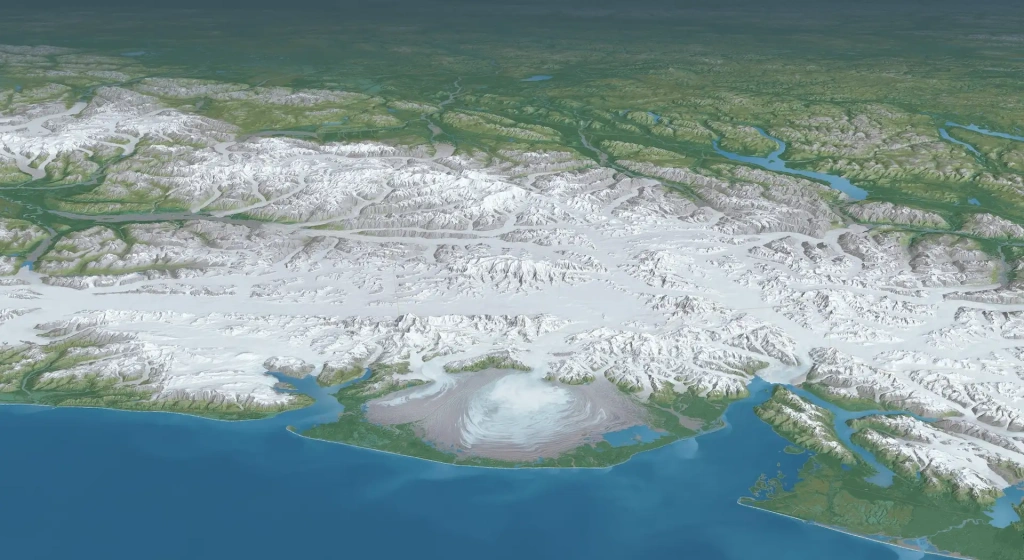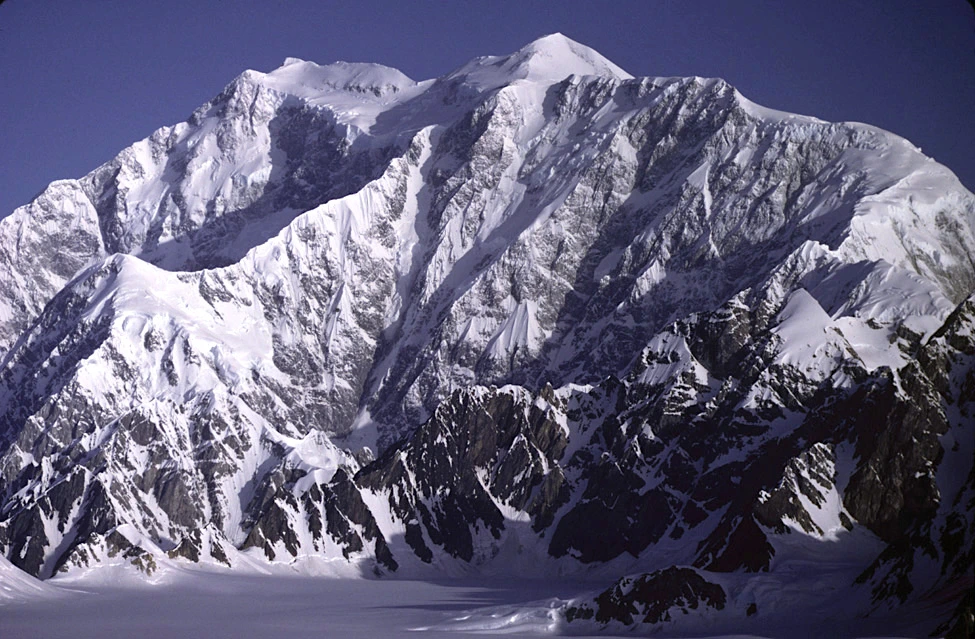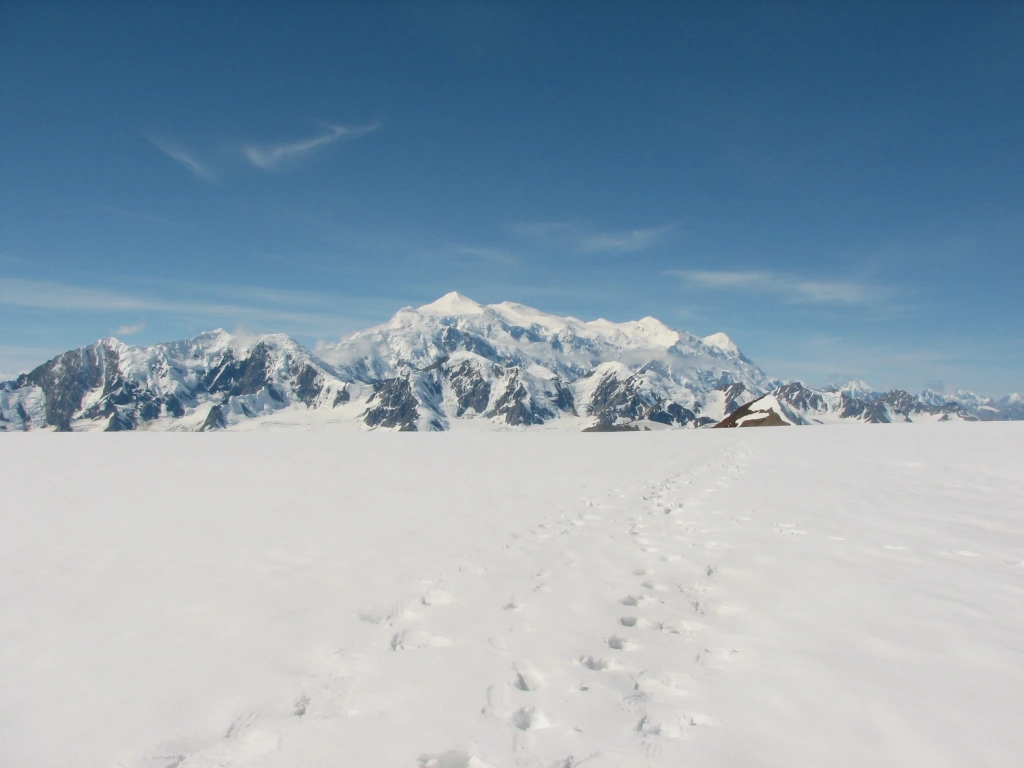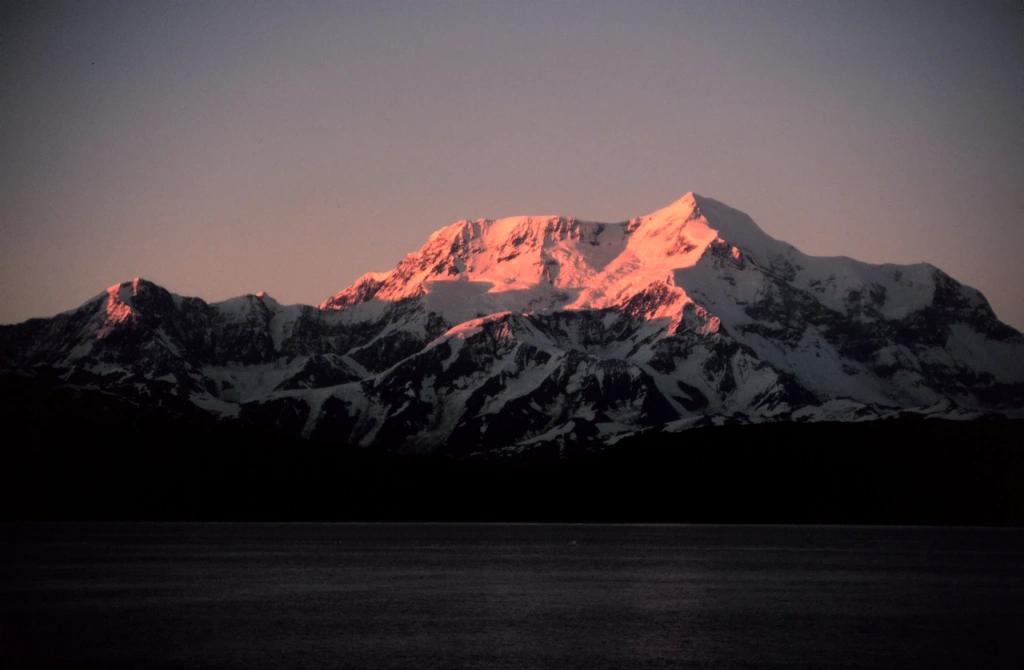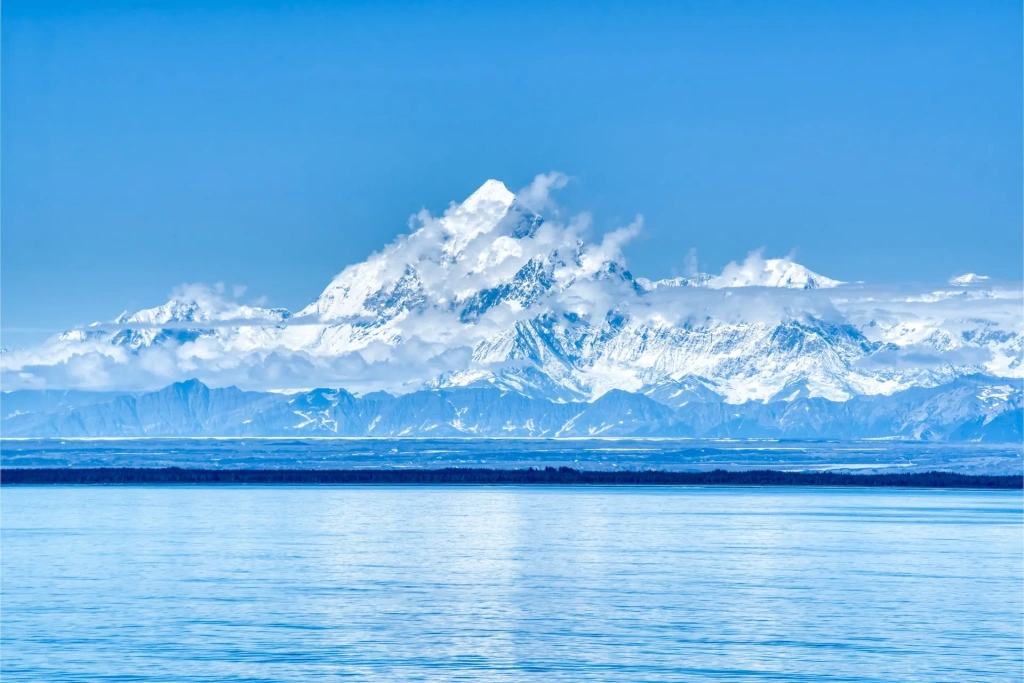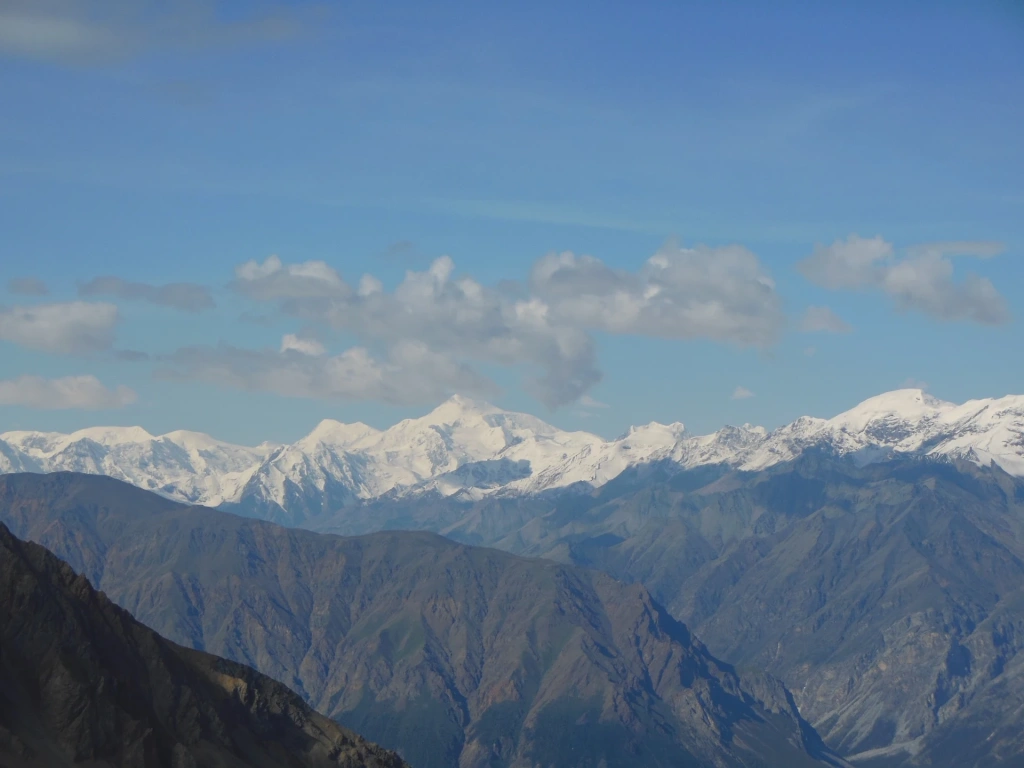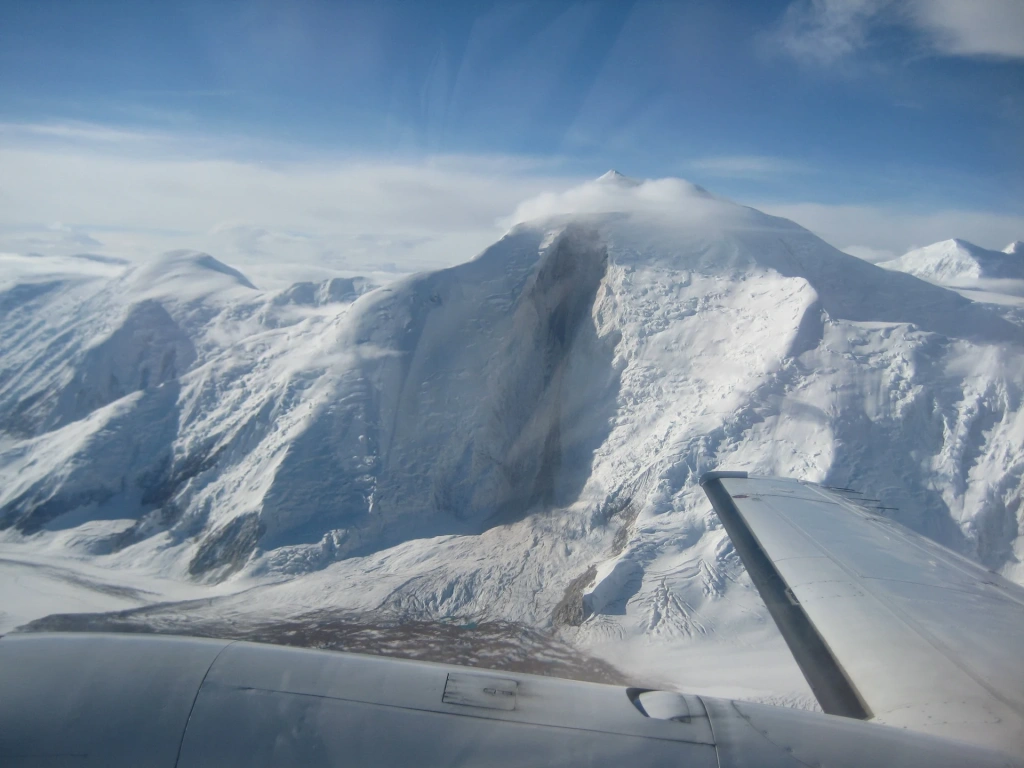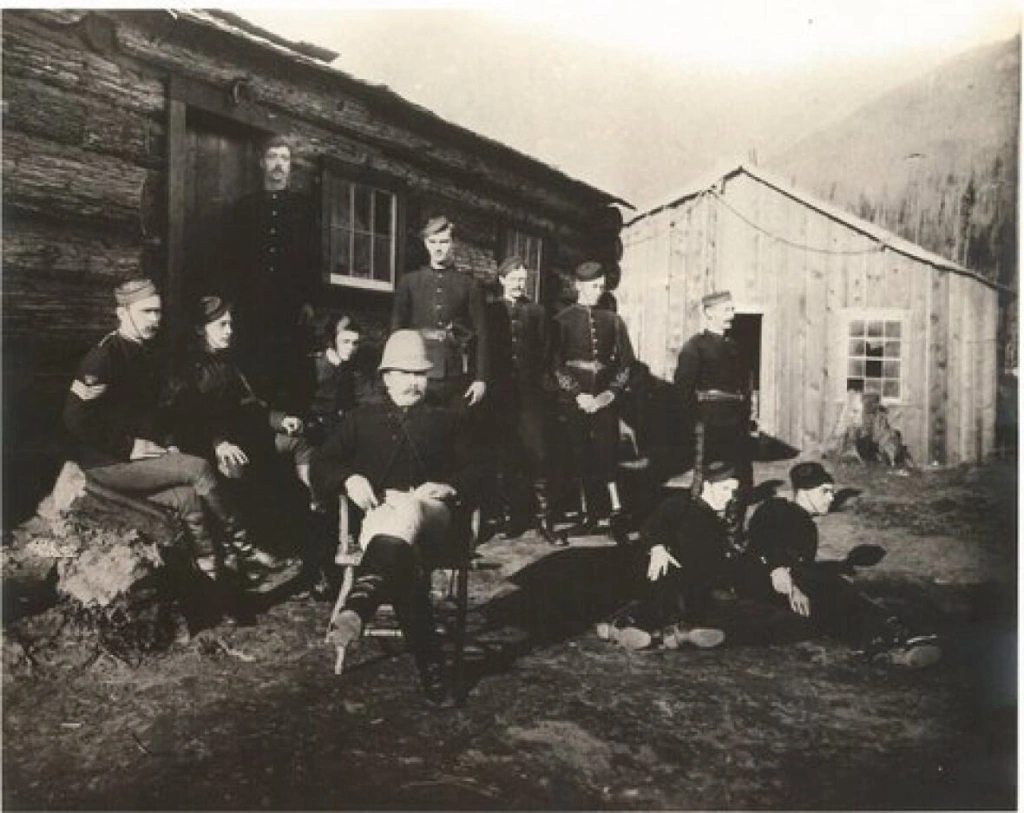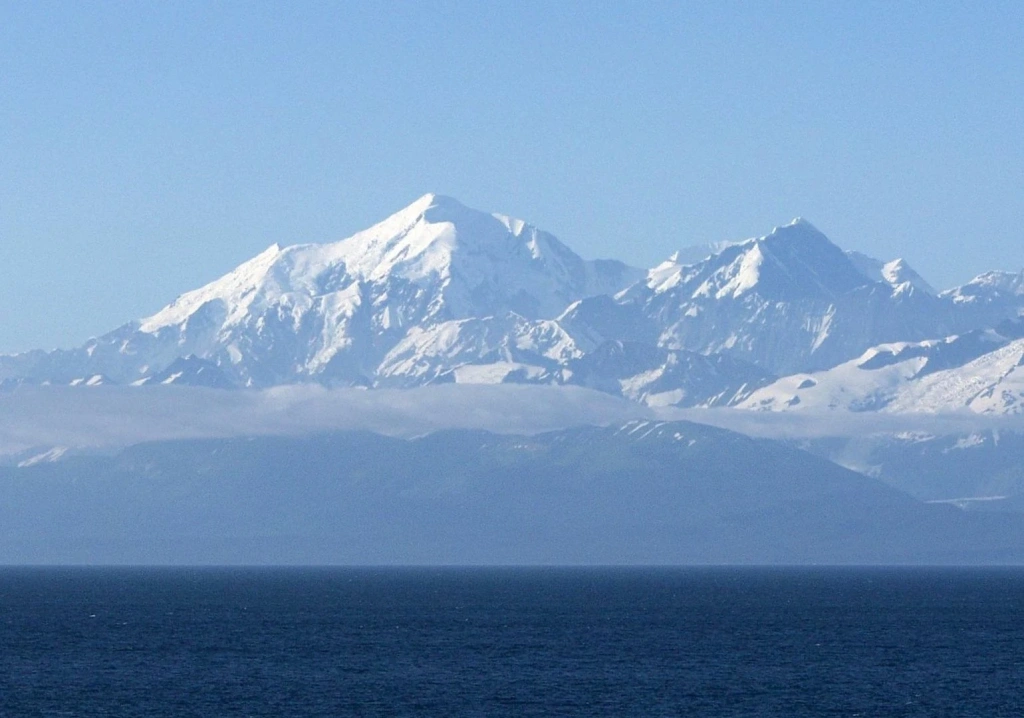Explore Canada’s tallest mountains from the perspective of climbing. Delve into the history of their first ascents and discover the origins of their names. In this article, we’ll also compare expeditions to these peaks with climbing Mount Kilimanjaro, Africa’s highest summit.
All the mountains on our Canadian list belong to the , which are part of the larger range. If we look for the Saint Elias Mountains on a world map, we’ll find them partially in Canada and partially in the U.S. state of Alaska.
Now, let’s focus on the mountains located within Canada. For clarity, we’ll exclude peaks that have a prominence of less than 500 meters (1,640 feet) compared to surrounding summits. Without this, the list would include secondary peaks of the same mountains and other summits that don’t significantly stand out in the landscape.
The highest mountain in Canada is Mount Logan. Let’s start with it.
Mount Logan — the highest mountain in Canada
The highest mountain in Canada is Mount Logan, which reaches 5,959 meters (19,551 feet) above sea level. This impressive, massive mountain is a true pride of Canada and a serious challenge for mountaineers aiming to reach its main summit. We’ll delve a bit deeper into its story compared to the other mountains on our list.
How tall is Mount Logan in Canada?
Mount Logan is 5,959 meters (19,551 feet) high. This figure was determined in 1992 by an expedition that set out to establish the precise height of Mount Logan, which was previously unknown. During this expedition, scientists also measured the mountain’s growth rate, which is approximately 0.5 millimeters annually.
Logan is second in height only to one other mountain in North America—, the highest on the continent. Comparing it to Africa’s highest peak, , Logan is taller just by 64 meters (210 feet).
Incidentally, if we ranked the world's tallest mountains by instead of absolute height, Logan would be in the top six, trailing only Everest, Aconcagua, Denali, Kilimanjaro, and Cristóbal Colón. We discuss this further in our provocatively-titled article titled “Is Everest really the tallest mountain in the world?”. Mount Logan's relative height is 5,250 meters (17,224 feet).
Name origin:
The mountain was named after Sir William Logan, a Canadian geologist who founded the Geological Survey of Canada. William Edmond Logan is renowned for creating the first detailed geological map of Canada and was knighted for his scientific achievements.
Interestingly, the Marvel superhero Wolverine was given the alias “Logan” in honor of Canada’s highest mountain. Wolverine’s creator, writer Chris Claremont, displayed a sense of irony by naming a short superhero after the tallest mountain in Canada.
First ascent of Mount Logan:
The first successful summit of Logan took place in May-June 1925. An expedition led by Albert MacCarthy lasted 65 days, hindered by bad weather and difficult terrain. The team faced strong winds, low visibility, steep rocky slopes, and glaciers. Some climbers suffered severe frostbite, but fortunately, there were no fatalities.
The difficulty of reaching Logan's main summit is highlighted by the fact that the next attempt was made only a quarter-century later, in 1950.
Climbing Mount Logan today:
Expeditions to Logan are considered highly challenging due to the harsh weather conditions and technical climbing sections. Several conditions must be met to participate in an expedition:
- The ascent must take place between late April and early July; winter expeditions are prohibited.
- The group must consist of at least four climbers; solo expeditions are strictly forbidden.
- Due to the high cost of rescue operations, expedition members must have insurance covering search and rescue.
Annually, only slightly more than 30 people attempt to climb Mount Logan. Expeditions usually last around three weeks.
Interesting features of the mountain:
Logan isn’t just a single mountain but rather an entire massif with numerous secondary peaks exceeding 5,000 meters (16,404 feet). The base of the massif spans over 100 kilometers (62 miles), making Logan one of the largest massifs on the planet. Several massive glaciers, such as the Hubbard Glacier, originate on Mount Logan and extend 122 kilometers (76 miles) to Yakutat Bay. Mount Logan is located in Kluane National Park and Reserve, which is home to 17 out of 20 highest peaks in Canada.
The mountain has a large snow-covered plateau over 20 kilometers (12 miles) long. In the 1960s, this plateau became the site of a record-breaking high-altitude plane landing. The plateau is situated at approximately 5,300 meters (17,388 feet) above sea level. During winter months, air temperatures here hover around -45 °C (-49 °F).
This plateau was also the site of a project studying the effects of high-altitude conditions on the human body. For this, the world’s highest-altitude laboratory at the time was built on Logan’s plateau. The research, which spanned ten years, was led by physician Charles Houston, who is known for being the first to describe high-altitude pulmonary edema (HAPE) and high-altitude cerebral edema (HACE). This study of mountain sickness was aptly named “Project Logan.”
Mount Saint Elias — 5,489 meters (18,009 feet)
Mount Saint Elias is the second-highest peak in Canada. Interestingly, it also features in another of our lists: the highest mountains in the USA. In both countries, it holds the second position. This is because the mountain is situated directly on the border between Canada and the U.S. state of Alaska, so its summit technically belongs to both nations.
How tall is Mount Saint Elias in Canada?
It stands 5,489 meters (18,009 feet) above sea level.
Name origin:
Many sources mention that the mountain was named by the explorer and cartographer Vitus Bering during his final expedition. Bering, a Russian cartographer of Danish origin, is the namesake of the Bering Sea and Bering Strait, which separate North America from Eurasia.
The usual explanation for the mountain's name is that Bering sighted the prominent peak on a day that, according to the Russian calendar, coincided with the Feast of Saint Elijah, and thus named the mountain accordingly. A diary entry from one of the expedition members confirms that they first saw Mount Saint Elias on July 16, 1741. However, there’s a discrepancy since Orthodox Russians at that time celebrated the feast of Saint Elijah on July 20.
In reality, on July 20, 1741, Bering’s expedition reached a cape on Kayak Island in what is now Alaska, USA. The cape was named after the biblical prophet by Vitus Bering. The mountain, however, remained unnamed. Later, cartographers noticed that the shape of the cape resembled that of the mountain, leading to the naming of Mount Saint Elias after the cape. Eventually, this name was extended to the entire mountain range, which includes almost all the peaks discussed in this article.
First ascent of Mount Saint Elias:
The first successful ascent of this mountain was accomplished by the famous Italian explorer and adventurer Prince Luigi Amedeo. His expedition reached the summit on July 31, 1897. Their goal was to locate the legendary Silent City of Alaska, which, according to stories told by prospectors and locals, stood above a mountain glacier. Of course, this turned out to be merely a mirage caused by optical illusions on the ice and snow at high altitudes.
An interesting fact that highlights the prince’s royal lifestyle even in the most challenging conditions: it’s said that his porters carried a comfortable copper bed for him up Mount Saint Elias.
Climbing Mount Saint Elias today:
This mountain is considered extremely challenging. Harsh climates and glaciers that cover the summit make it a serious endeavor for climbers. Only the most experienced mountaineers attempt to conquer it.
Interesting features of the mountain:
One of the most notable characteristics of Mount Saint Elias is the massive glaciers that descend from its slopes almost to sea level. This makes it the most visually prominent mountain in the region. It’s fitting that, although not the highest peak in the range, it lends its name to the entire mountain range.
Incidentally, in the Tlingit language, spoken by the native inhabitants, the mountain is called "the big mountain" or “mountain at the head of Icy Bay”
Mount Lucania — 5,240 meters (17,192 feet)
The third highest mountain in Canada is Mount Lucania, also located in Yukon, like all of the first 18 mountains on our list.
How high is Mount Lucania in Canada?
It stands 5,240 meters (17,192 feet) tall above sea level.
Name origin:
The name "Lucania" has an interesting story behind it. This mountain was named by the same Italian explorer, Luigi Amedeo. Standing atop Mount Saint Elias, he spotted another mountain in the distance. Its shape apparently reminded him of the steamship on which he had sailed from Europe to North America. This was the luxurious and fastest liner of its time, the "Lucania" — the first ship equipped with Marconi’s wireless telegraph system.
The word "Lucania" is the historical name of a region in southern Italy, now known as Basilicata. In ancient times, Lucania was a wealthy, independent country inhabited by the Lucani people. It seems that the Italian prince was quite fond of this name and couldn't resist bestowing it upon a mountain. Thus, a piece of Italian history became part of Canada’s present.
First ascent of Mount Lucania:
Despite giving the mountain its name, Prince Luigi Amedeo never climbed it. The first ascent was made by mountaineers Bradford Washburn and Robert Bates in 1937.
The story of this expedition is unusual. In order to reach the glacier on the mountain, the climbers used the services of the famous American pilot Robert Reeve. His single-engine aircraft had skis, allowing him to land on the glacier. He set a world record by landing at the highest altitude. However, it took five days for the plane to take off again because it sank deep into the thawing snow and slush. Reeve later called this flight the most dangerous of his career.
Washburn and Bates, after resolving Reeve’s problem and freeing the plane, reached the mountain’s summit and safely descended to the nearest settlement. However, to reduce the plane’s weight, they had to abandon almost all their equipment, including cameras and surveying instruments. For 85 years, the equipment lay high on the glacier. In 2022, a group of skiers discovered the old cameras and other gear. The glacier, moving and melting, had "transported" Washburn’s abandoned items 22 kilometers (13.7 miles) away.
Climbing Mount Lucania today:
This mountain is considered to have moderate difficulty and requires good mountaineering skills. Although the route to its summit isn’t as popular as those of Logan or Mount Saint Elias, expeditions to Lucania are regularly undertaken.
Interesting features of the mountain:
Lucania offers breathtaking views of the surrounding glaciers and nearby peaks. The snow-covered panoramas are well worth admiring from the third-highest peak in Canada.
King Peak — 5,173 meters (16,972 feet)
Canada’s fourth-highest mountain is King Peak, often considered a satellite peak of Logan, though it is recognized as a separate mountain. It ranks ninth among the highest mountains in North America.
How tall is King Peak in Canada?
King Peak is 5,173 meters (16,972 feet) above sea level.
Name origin:
First, let’s note that this mountain is sometimes referred to simply as "Mount King." Some sources state that King Peak was named in honor of William King, a surveyor, and inspector of geological surveys, and later the chief astronomer of Canada.
However, we also know that there is another Mount King located in the province of British Columbia. It has an elevation of 2,868 meters (9,409 feet), and it was definitely named after William King. Moreover, in the same British Columbia, there is another peak called Kings Peak. It stands at 2,848 meters (9,344 feet) and is part of the Canadian Rockies. Americans might find it easy to get confused since there are also two Kings Peaks in the United States: one in Nevada and one in California. Hang in there; this naming confusion isn't over yet.
In British Columbia, there is a mountain named Kings Peak. The plural in the name suggests that it refers to two 'Kings' who made an expedition to it, but they were different Kings. Apologies, but we must also add that there are a couple more Kings Peaks in the United States: one in Utah and another in Idaho.
Frankly, we couldn’t fully untangle the naming history of this majestic beauty located in Yukon.
First ascent of King Peak:
The fourth-highest peak in Canada was conquered relatively late—in 1952. This is due to its steep slopes. Four students from the University of Alaska—Russell Page, Keith Hart, Elton Thayer, and Bill Atwood—successfully reached the summit on June 6. They set out on foot, and their supplies and equipment were later air-dropped to them. As you can see, aviation played a significant role in the first ascents of these rugged Canadian mountains. The expedition was no easy feat—some climbers sustained injuries, and they all faced a severe storm.
Climbing King Peak today:
The steep, uneven slopes and harsh weather conditions continue to protect King Peak from uninvited guests. Each year, only a handful of experienced climbers attempt to conquer it. These are the people with significant experience who seek challenges.
Interesting features of the mountain:
Although King Peak is a test of endurance, it offers unmatched experiences and rewards those who reach the summit with stunning views of the snow-covered surroundings. The distinctive pointed pyramid shape of this majestic peak is particularly striking, attracting many climbers. Let’s wish them safe ascents!
Mount Steele — 5,073 meters (16,644 feet)
Mount Steele is Canada’s fifth-highest peak and the last to exceed 5,000 meters above sea level.
How tall is Mount Steele?
It is 5,073 meters (16,644 feet) tall. However, this isn’t precise. It’s an older, unverified measurement that represents the upper limit. The lower limit is 5,020 meters (16,469 feet). Modern topographic maps of Canada indicate Steele’s height as 5,020 ± 20 meters.
Name origin:
The mountain was named in honor of a prominent Canadian historical figure, Sam Steele. He was a hereditary military officer, a brave cavalryman, a law enforcement officer in Yukon, and later a commander of troops in Europe and even Africa.
A man of honor, Steele skillfully handled complex matters between the Canadian government and the indigenous peoples of the North, respecting their interests. It seems that Steele was influenced by the novels of James Fenimore Cooper, which he avidly read in his youth. Life threw many challenges at him, and he seemed to handle them with great skill.
Steele first led one of the units of the North-West Mounted Police, which maintained order along the Alaska border. He later successfully managed the influx of adventurers and desperate fortune-seekers during the Klondike Gold Rush. During the Second Anglo-Boer War, he was sent to South Africa to carry out the British Empire’s difficult task of quelling uprisings. He also participated in World War I, commanding Canadian units in Europe. His distinguished military service earned him a knighthood. Some episodes of his life even appeared in historical novels written by his son.
First ascent of Mount Steele:
The first successful expedition to the summit of Mount Steele took place in 1935 under the leadership of Walter Wood. The group included a woman—Wood’s wife, Foresta. The ascent was difficult due to continuous snowfalls. These were so intense that the group had to remain in camp for many days, waiting for a suitable "window" to proceed.
When the climbers finally reached the plateau, they encountered slippery crusty snow formed by the winds blowing across the steep slopes. The entire group had to crawl on all fours to reach the summit, presenting a rather comical sight. It was as if the mountain was mocking its first guests, testing their resilience and ingenuity.
However, once at the summit, the team was rewarded with a pleasant surprise—half an hour of beautiful, windless weather with excellent views.
Climbing Mount Steele today:
Mount Steele is described as having moderate difficulty. Mountaineering skills are definitely required, particularly for navigating glaciers. The mountain is less popular than other peaks in the Saint Elias range, such as Mount Logan, which means fewer climbers attempt it each year.
Interesting features of the mountain:
Mount Steele is known for large-scale avalanches and landslides caused by slipping glaciers, which provoke the movement of rocks, ice, and snow. These events are difficult to predict, adding an element of risk for those attempting to climb the mountain.
All the remaining mountains in Canada do not exceed 5,000 meters (16,404 feet) in absolute height, so we’ll provide shorter descriptions for them.
Mount Wood — 4,842 meters (15,886 feet)
Mount Wood is the sixth-highest peak in Canada, situated in the Saint Elias Mountains in Yukon.
Height: 4,842 meters (15,886 feet) above sea level.
Name origin: Mount Wood was named in honor of Zachary Taylor Wood, a significant figure in Canadian history. Wood was a cavalry officer in the North-West Mounted Police and played a crucial role in maintaining law and order during the Klondike Gold Rush in Dawson City, Yukon. His leadership helped to stabilize the region during a time of intense social and economic change.
First ascent: The first successful ascent of Mount Wood was achieved in 1941, led by Walter Wood. Interestingly, this was Walter Wood’s second attempt to summit the mountain that shared his name; his first attempt a couple of years earlier had been thwarted by poor weather conditions.
Climbing Mount Wood today: The climb to the summit of Mount Wood is considered to be of moderate difficulty, though it is less challenging than the higher peaks in the Saint Elias range. Nevertheless, it still requires good mountaineering skills. The route is less popular than others, which means fewer climbers attempt it each year.
Mount Vancouver — 4,812 meters (15,787 feet)
Mount Vancouver is the seventh highest mountain in Canada. If we include all of North America, Vancouver ranks 15th.
Height: 4,812 meters (15,787 feet) above sea level.
Name origin: The mountain was named after the English explorer and navigator George Vancouver. His expedition was one of the most significant for the exploration of North America. He created the first accurate map of the continent’s west coast from Alaska to California. For the first time, all the details of what is now British Columbia, Vancouver Island, and parts of Alaska were mapped thanks to this traveler.
No wonder so many geographic features in North America are named after him. These include two cities, one in Canada and one in the U.S., as well as a large island, a bay, and a river. The seventh-highest mountain in Canada is also named after George Vancouver. By the way, Mount Vancouver in New Zealand’s Southern Alps is also named after him.
First ascent: The first expedition to reach the summit took place in 1949. Its participants were William Hainsworth, Alan Bruce-Robertson, Bob McCarter, and Noel Odell.
Climbing Mount Vancouver today: One notable feature of Mount Vancouver is that it is divided by the border between the U.S. and Canada. The northern summit, the highest, is located in Yukon, while the southern side is in Alaska. Climbing Mount Vancouver is considered difficult due to the glacial sections of the route. Nevertheless, expeditions still set out to reach its summit from time to time.
Mount Slaggard — 4,742 meters (15,558 feet)
Mount Slaggard is the eighth-highest peak in Canada. It is often referred to as the least known of the top 10 Canada's highest peaks. Indeed, little information is available about it.
Height: 4,742 meters (15,558 feet) above sea level.
First ascent: The first successful ascent of Mount Slaggard was accomplished in 1959 by a large group of climbers, including at least eight people, which is unusual for a first ascent. This mountain was one of the last major icy peaks in Canada to be conquered.
Climbing Mount Slaggard today: Mount Slaggard is not popular among climbers, mainly due to its remote location and harsh weather conditions. The window of favorable weather is very short, typically from mid-June to mid-September.
Mount Fairweather — 4,671 meters (15,325 feet)
Mount Fairweather is partially located in Alaska and partially in British Columbia, Canada. It is the ninth-highest peak in Canada.
Height: 4,671 meters (15,325 feet) above sea level. Due to its proximity to the Pacific Ocean, this impressive height makes it one of the highest coastal mountains in the world.
Name origin: Mount Fairweather was named by the famous explorer Captain James Cook during his third voyage around the world in 1778. As Cook’s expedition approached the North American coast, they encountered a severe storm that caused significant damage to their ships. After making repairs, Captain Cook was so pleased with the unusually good weather they encountered upon sighting the mountain that he named it "Fairweather." The irony, however, is that the weather in this region is usually poor, with frequent storms and heavy precipitation.
First ascent: Various groups attempted to ascend Mount Fairweather over the years, but success came in 1931 to American climbers Allen Carpe and Terris Moore. This was Carpe’s second attempt, as his first had failed due to the difficult terrain. The climb, which began on April 17 and concluded on June 7, was repeatedly delayed by storms and snowfalls, making the mountain’s name seem like a mocking jest.
Mount Hubbard — 4,557 meters (14,951 feet)
Rounding out our top 10 highest mountains in Canada is Mount Hubbard, located on the border between Yukon and Alaska. It's the tenth-highest peak in the country.
Height: 4,557 meters (14,951 feet) above sea level.
Name origin: The mountain is named after Gardiner Greene Hubbard, the founder and first president of the National Geographic Society. Hubbard was a successful lawyer and businessman with a passion for scientific achievements. His financial success allowed him to fund various projects, including those of the National Geographic Society, which today is known and loved worldwide.
Hubbard also played a key role in establishing the academic journal Science and financed the experiments of his son-in-law, inventor Alexander Graham Bell. Essentially, Hubbard was the entrepreneur who not only helped invent the telephone but also facilitated its spread worldwide.
In the context of our story, Gardiner Hubbard funded a major expedition led by geologist Israel Russell, who proposed naming the previously unnamed mountain after his benefactor Hubbard. It was a fitting tribute to a man whose contributions to science and exploration were significant.
First ascent: The first successful ascent of Mount Hubbard was completed on July 26, 1951, by an expedition led by Walter Wood.
The next eight highest mountains in Canada are also part of the Saint Elias Mountains:
- Mount Walsh — 4,507 meters (14,787 feet)
- Mount Alverstone — 4,420 meters (14,501 feet)
- Mount MacArthur — 4,344 meters (14,252 feet)
- Mount Augusta — 4,289 meters (14,070 feet)
- Mount Strickland — 4,260 meters (13,976 feet)
- Mount Avalanche — 4,228 meters (13,871 feet)
- Mount Cook — 4,194 meters (13,759 feet)
- Mount Craig — 4,040 meters (13,255 feet)
Only the 19th mountain on our list represents a different mountain system, specifically the Coast Mountains. The highest mountain in the range is Mount Waddington, which rises to 4,019 meters (13,186 feet) above sea level. Following it are mountains below 4,000 meters, at which point we’ll stop.
As we can see, the top ten highest mountains in Canada are comparable in height to the ten highest mountains in Africa. Africa’s highest peak, the snow-capped Mount Kilimanjaro, is surpassed by only one summit in Canada—Mount Logan. However, in terms of popularity among climbers, all of Canada’s top peaks together fall far short of Kilimanjaro. Only a few people, sometimes a few dozen, attempt to climb each of the Canadian top peaks annually, whereas more than 50,000 people climb Kilimanjaro each year.
If you want to participate in an expedition to the "Roof of Africa" and see snow on the equator with your own eyes, join one of our regular Kilimanjaro group expeditions. Climbing Kilimanjaro is much easier than conquering Canadian peaks and is also far less expensive.
For those who want to learn more about mountains, we recommend a few other interesting selections in the Altezza Travel blog. Read about the mountains on the list of the Seven Summits, find out which mountains on our planet are the most ancient in the article "10 Oldest Mountains in the World," and explore our list of the most dangerous mountains to climb on Earth, which have claimed the lives of many fearless climbers. We hope nothing of the sort happens to you!











